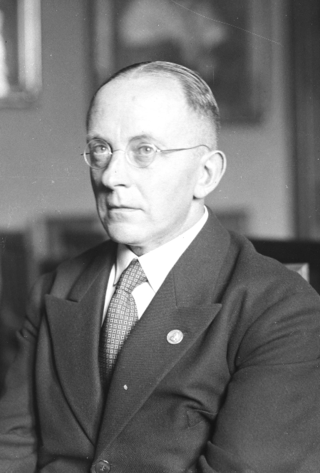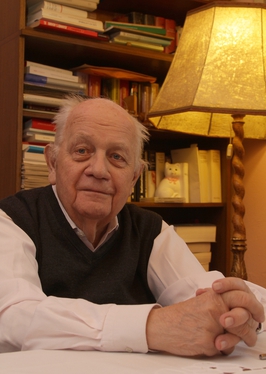
Pączki are filled doughnuts found in Polish cuisine.

Max Julius Friedrich Vasmer was a Russian and German linguist. He studied problems of etymology in Indo-European, Finno-Ugric and Turkic languages and worked on the history of Slavic, Baltic, Iranian, and Finno-Ugric peoples.
A bema was an elevated platform used as an orator's podium in ancient Athens. The term can refer to the raised area in a sanctuary. In Jewish synagogues, where it is used for Torah reading during services, the term used is bima or bimah.

Radegast or Radogost is, according to medieval chroniclers, the god of the Polabian Slavs, whose temple was located in Rethra. In modern scientific literature, however, the dominant view is that Radegast is a local nickname or a local alternative name of the solar god Svarozhits, who, according to earlier sources, was the chief god of Rethra. Some researchers also believe that the name of the town, where Svarozhits was the main deity, was mistakenly taken for a theonym. A popular local legend in the Czech Republic is related to Radegast.

Manfred Mayrhofer was an Austrian Indo-Europeanist who specialized in Indo-Iranian languages. Mayrhofer served as professor emeritus at the University of Vienna. He is noted for his etymological dictionary of Sanskrit.

Aleksander Brückner was a Polish scholar of Slavic languages and literature (Slavistics), philologist, lexicographer, and historian of literature. He is among the most notable Slavicists of the late 19th and early 20th centuries, and the first to prepare complete monographs on the history of the Polish language and culture. He published more than 1,500 titles and discovered the oldest extant prose text in Polish.
Słownik etymologiczny języka polskiego is an etymological dictionary first published in 1927. It was compiled by Aleksander Brückner and served through the 20th century as a principal Polish etymological dictionary.
Some loanwords in the variant of the Hurrian language spoken in Mitanni during the 2nd millennium BCE are identifiable as originating in an Indo-Aryan language; these are considered to constitute an Indo-Aryan superstrate in Mitanni. The words are theonyms, proper names and technical terminology related to horses (hippological).
The Indo-European Etymological Dictionary is a research project of the Department of Comparative Indo-European Linguistics at Leiden University, initiated in 1991 by Peter Schrijver and others. It is financially supported by the Faculty of Humanities and Centre for Linguistics of Leiden University, Brill Publishers, and the Netherlands Organisation for Scientific Research.
The Französisches Etymologisches Wörterbuch or FEW is the principal etymological dictionary of the Gallo-Romance languages. It was the brainchild of the Swiss philologist Walther von Wartburg.
Kurt Baldinger was a Swiss linguist and philologist who made important contributions to Romance studies in the Gallo-Romanic and Ibero-Romanic branches, with works of lexicography, historical linguistics, etymology and semantics.
While many Slavic languages officially use Latin-derived names for the months of the year in the Gregorian calendar, there is also a set of older names for the twelve months that differs from the Latin month names, as they are of Slavic origin. In some languages, such as the Serbian language these traditional names have since been archaized and are thus seldom used.
Cetno i licho is a simple game of chance, of ancient European provenance, where the players had to guess if the hidden objects were even or odd in number, with licho also meaning 'bad luck' or 'devil'. The counted objects could also be white or black pawns or lines drawn in ashes, and the game had mystical overtones of invoking the Sudice, the Slavic counterpart of the Fates.

The Etymological Dictionary of the Altaic Languages is a comparative and etymological dictionary of the hypothetical Altaic language family. It was written by linguists Sergei Starostin, Anna Dybo, and Oleg Mudrak, and was published in Leiden in 2003 by Brill Publishers. It contains 3 volumes, and is a part of the Handbook of Oriental Studies: Section 8, Uralic and Central Asian Studies; no. 8.
The Dictionnaire étymologique de l'ancien français (DEAF) is an etymological dictionary of Old French. The lexicographic project was born in the mid-sixties of the 20th century and has been in progress ever since with its headquarters at the Heidelberg Academy of Sciences and Humanities (Germany). Known and valued amongst linguists, philologists and medievalists alike for its high lexicographic standards it is considered one of the most important works in the field of historical lexicography.
Bardhyl Demiraj is an Albanian linguist and Albanologist. He is considered one of the leading experts in the study of Albanian etymology.

Ferdinand Holthausen was a German scholar of English and old Germanic languages.

The earliest dictionaries of the Polish language were bilingual aids, usually Polish–Latin, and date to the 15th century. The first dictionary dedicated solely to the Polish language was published in the early 19th century. Many dictionaries of the Polish language are named simply "the Dictionary of the Polish Language" or in similar fashion.







